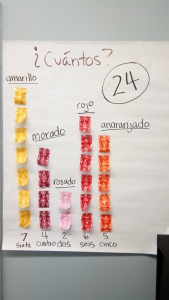Do you have a ‘bag of tricks”? I shared some in my last post about my advice for teaching younger students. But I wanted to share some of the activities and “tricks” I have collected from multiple people over the years. After you have taught a little, you start to have a “bag of tricks” which are reliable activities that you know will work well. So here is one of the activities from my bag of tricks for younger students. Ironically enough I call it …
¿Qué hay en la bolsa? – What’s in the bag?
I first learned this activity from Carol Gaab. Basically you put things in a bag and the kids pull it out one by one. Too simple? Oh no, it’s magic. There is something about the mystery of not knowing what is in the bag. We have a chant in my class that we say until someone picks something out of the bag.
Here are some things I put in the bag for my students and the structures I am targeting.
se llama (he/she calls himself/herself)– This is an activity I want to try for next year. The first day of class for my Kindergarten is all about learning their names and letting them have fun with me in Spanish. So I want to have notecards with their names in the bag. Then I am going to tell them that the bag is MAGIC. It can tell me their names. Then I will have students come up to pull out their name. Of course the odds are that it will be wrong name, but that is too funny pretending to be confused with the bag giving the wrong name. The big pay off is I get to know their names in a fun way while teaching se llama (he/she calls himself/herself).
se llama (he/she calls himself/herself)– I have laminated pictures of famous people my kids know. Elmo, Phineas and Ferb, President Obama, etc. I pretend not to know their names. I even make some wrong guesses. Then I have the kids tell me their names.
hay / los colores (there is/are, colors) – The starburst activity is also from Carol Gaab. You put starbursts in the bag and discuss what colors the students pick. You can also add in quiere (wants) by asking the student which color they want then letting them pick and tiene (has) telling what they have. I also like to get the kids to keep their wrappers for me. Then we put them into a bar chart to discuss how many red/orange/yellow starbursts we ate.

animales & grande / pequeño (animals & big/small) – Pictures of dogs, cats or any other animals is various sizes and colors. I love to throw in crazy colors like blue, green, or pink. Then as the students pull them out of the bag, I like to display them in a pocket chart to compare and contrast as we go. (How many dogs are there? How many big dogs are there? How many pink animals are there? etc.)
Señor Patata (Mr. Potato Head) -One of my favorites! I wrote about this in a previous post. I have now added Señora Patata to our classroom. I use this activity for lots of target structures like tiene (has), quiere (wants), necesita (needs), no puede (can’t), and body parts.
¿Te gusta? (Do you like?)– I could put in all kinds of objects for this. I usually have props of fake food. The student pulls out the food and then we discuss if we like it. You could also use pictures with different restaurants.
El Numero (The Number) – I read about this one somewhere but can’t remember. If you recognize it then let me know so I can give credit. I have all the numbers spelled out on pieces of paper. They are on strips of card stock and laminated. At the beginning I have all the numbers in a pocket chart and we count together to the designated number (1-10, 1-20 etc.) Then I put all the numbers in the bag. I pull out the secret number from the bag. I don’t show the students the number. Then they have to guess what is the missing number. They tell a partner or me (to keep things honest) and then we start to pull numbers out of the bag one by one until we figure out which number is missing. This can be done in one sitting or over multiple classes.
¿Qué es? (What is it?) I got this idea from a group of CI teachers in Chattanooga. Deborah Tucker and Jennifer Raulston from the Chattanooga School for the Arts and Sciences told us about this activity they use in their elementary French class. Take an object and put it in a box or bag. Then have students feel inside. They can describe it to the class (hard, soft, big, small, has hair, etc.) Then the class tries to guess what it is.
La bolsa mágica (the magic bag)- This is an activity I read about on Martina Bex’s site. It is an activity maybe for an older and more advanced group but I love the creativity of taking simple objects and giving them such meaning.
Have you used an activity like this in your classroom? What did you do?

[…] via What’s in the bag? — Mrs. Spanish’s class […]
[…] bag: Anne Marie Mitchell says: “You put starbursts in the bag and discuss what colors the students pick. You can also […]
[…] What is in the Bag? […]